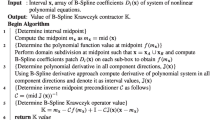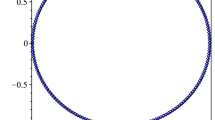Abstract
The functional atlas of the initial system of nonlinear differential equations is split into local charts with the help of a multidimensional Taylor series expansion. In each chart, the approximation with a weakly nonlinear Volterra-Wiener series up to the fourth order is used, where a chart is changed when its boundaries are crossed. It is established that the obtained approach allows one to increase the accuracy and reliability of the calculated output response of the nonlinear system as compared to the classical Volterra-Wiener series approach. The results of the numerical simulation of a nonlinear RC circuit are presented and the efficiency of the proposed method is shown.
Similar content being viewed by others
References
S. A. Maas, Nonlinear Microwave and RF Circuit (Artech House, London, 2003).
E. A. Volkov, Nonlinear Characteristics of Electrical Devices: Calculation Methods. Educational Manual (UMK MPS Rossii, Moscow, 2000) [in Russian].
S. A. Maas, Microwaves RF 38(5), 55 (1999).
V. Wouw, H. Nijmeijer, D. Van Campen, Nonlinear Dynamics, 27, 397 (2002).
A. Zhu, J. Pedro, and T. Brazil, IEEE Trans. Microwave Theory Tech. 54, 4323 (2006).
A. Zhu, J. Pedro, and T. Cunha, IEEE Trans. Micro-wave Theory Tech. 55, 813 (2007).
N. Wiener, Nonlinear Problems in Random Theory (Technology, New York, 1958).
V. Volterra Theory of Functionals and of Integral and Integro-Differential Equations (Dover, New York, 1959).
Yu. S. Zav’yalov, B. I. Kvasov, and V. L. Miroshnichenko, Methods of Spline Functions (Nauka, Moscow, 1980) [in Russian].
B. A. Dubrovin, S. P. Novikov, A. T. Fomenko, Contemporary Geometry: Methods and Applications (Editorial URSS, Moscow, 1998), Vol. 2 [in Russian].
V. V. Khutortsev and V. N. Taran, Radiotekh. Elektron. (Moscow) 31, 2180 (1986).
H. Poincare, On Curves Defined by the Differential Equations (OGIZ, Moscow, 1947) [in Russian].
J. Bussgang, L. Ehraman, and J. Graham, Proc. IEEE 62, 1088 (1974).
W. Rugh, Nonlinear System Theory. The Volterra/Wiener Approach (Web Version, 2002); http://reslib.com/book/
E. B. William and C. Richard, Elementary Differential Equations and Boundary Value Problems (Wiley, New York, 2000).
E. I. Yurevich, Automatic Control Theory (Energiya, Moscow, 1969) [in Russian].
Fundamentals of Automatic Control, Ed. by V. S. Pugachev (Nauka, Moscow, 1974) [in Russian].
I. I. Krinetskii, Computation of Nonlinear Automatic Systems. Textbook for Technological Institutes (Technika, Kiev, 1974).
Author information
Authors and Affiliations
Corresponding author
Additional information
Original Russian Text © A.N. Taran, V.N. Taran, 2014, published in Radiotekhnika i Elektronika, 2014, Vol. 59, No. 7, pp. 702–710.
Rights and permissions
About this article
Cite this article
Taran, A.N., Taran, V.N. Application of Volterra-Wiener spline series for the analysis of nonlinear electric circuits. J. Commun. Technol. Electron. 59, 758–766 (2014). https://doi.org/10.1134/S1064226914060199
Received:
Published:
Issue Date:
DOI: https://doi.org/10.1134/S1064226914060199




